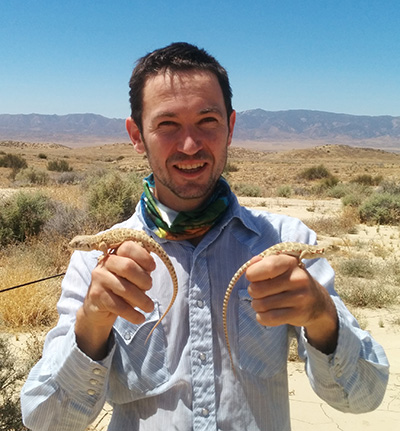Campus News
Drought helps predict how climate change might affect an endangered species
A study documenting the effects of California’s drought on an endangered lizard provides a glimpse into the future.

A new study documenting the negative effects of California’s drought on an endangered lizard in the San Joaquin Desert provides a glimpse into the potential effects of future droughts expected in California as a result of climate change. The findings, published May 2 in the online journal PLoS One, may also provide guidance on how to buffer these negative effects to avoid species extinctions.
Coauthor Barry Sinervo, professor of ecology and evolutionary biology at UC Santa Cruz, said the endangered blunt-nosed leopard lizard could face major losses of suitable habitat due to climate change. In the new study, Sinervo, UCSC graduate student Joseph Stewart, and collaborators at the Bureau of Land Management, California Department of Fish and Wildlife, and The Nature Conservancy looked at the effects on this species of the 2012-2014 drought, the most severe multi-year drought in southwestern North America in the past 1,200 years.
“Based on our observations of range-wide collapse of recruitment during the drought, the future picture for the blunt-nosed leopard lizard is not all that rosy,” Sinervo said.
Potential extinction
The fieldwork for the study took place in the fall of 2014. Preliminary surveys of blunt-nosed leopard lizards in the San Joaquin Desert revealed that some populations failed to reproduce during the drought, causing concern about potential extinction effects on this critically endangered species. To determine whether this phenomenon was widespread or isolated to particularly vulnerable populations, the researchers rapidly deployed personnel to conduct surveys of all known blunt-nosed leopard lizard populations.
“When the drought hit, we were positioned to team up with our partners and take advantage of this unique opportunity to assess the potential effects of climate change on a vulnerable species,” said Mike Westphal, BLM ecologist and lead author of the study. “Thanks to the geographic nature of the study, we were also able to identify key climate refugia for the species.”
Previous studies had documented links between drought and reproduction in populations of blunt-nosed leopard lizards. Because the drought produced geographic variation in the amount of rainfall across all of the populations of blunt-nosed leopard lizards, the new study was able to demonstrate this relationship range-wide, allowing researchers to exploit the drought to predict how future climate change might affect the extinction potential of the blunt-nosed leopard lizard and other desert-adapted endangered species.
“This study has serious implications not just for animals in California, but potentially for species all over the world affected by climate change. Our work suggests that the drought of 2012-2014 has had serious effects on the long-term survival of the blunt-nosed lizard, and significant intervention may be needed to preserve the future of these animals,” said coauthor Scott Butterfield of the Nature Conservancy. “As we consider the fallout from rising temperatures in California, it’s important to think of what would best help species like the blunt-nosed leopard lizard survive — which includes preserving valuable desert habitat.”
The study provides an excellent example of how collaborative research among land management agencies, wildlife agencies, non-governmental organizations, and universities can produce important insights into the potential effects of climate change. The results of the study are anticipated to guide ongoing conservation efforts in the San Joaquin Desert region of California. More importantly, the success of the study should provide encouragement to other researchers to take full advantage of extreme weather events such as historic droughts to learn about the future potential effects of climate change.